Euro 2020 was an intriguing international tournament that came after an incredibly intense two seasons of club football, and as with any international tournament, it seemed as though set pieces would play a major role. In truth though, set pieces were not as well utilised offensively as we’ve seen previously, and only five teams scored over one goal from dead balls according to FBref.com, with all these teams only scoring two goals at the tournament.
Despite this, there were a large number of interesting tactics and routines around set-pieces, and this article will take you through ten of the most interesting routines used at Euro 2020. I have deliberately labelled these set pieces as the most interesting, rather than ‘the best’ as often lots of learning is missed from routines which are unsuccessful.
We will start with the free kicks, then move onto the corners.
Routine one- Exploiting man-marking from free-kicks
Most teams mark zonally from free-kicks, with this allowing for coverage across the width of the 18-yard box usually and nullifying space for the opposition to head in and into. England used more man-oriented marking at the tournament, and so their shape changes depending on where the opposition attackers position. Denmark, with set-piece specialist Mads Buttergeit on their staff, devised a nice routine to show how this can be exploited.
We can see this routine below, where Denmark deliberately start in a very compact shape offensively, which sees England’s shape also become very compact. Compactness is generally good, but over compactness is something that can be exploited on free kicks, as if England’s defenders get too close to each other, they leave spaces wider. Therefore, the aim here is to force England into a compact shape and then exploit the space wider.
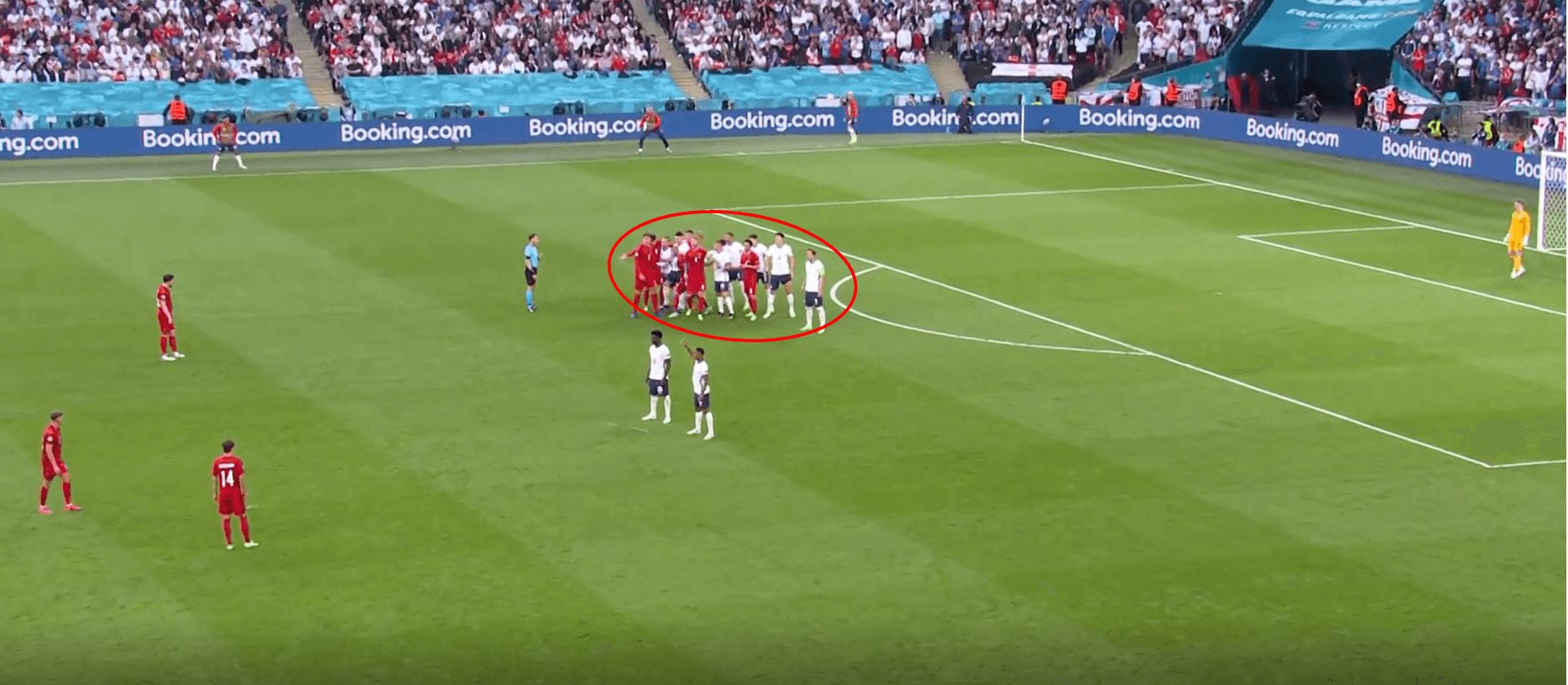
To exploit this then, Denmark position target player Jannik Vestergaard wide, and position a player behind him to block his man marker. As a result, Vestergaard can spin round and out of this block, while his marker is blocked from behind and trapped within the block. The downfall of the routine though is that we can see Denmark don’t block the lanes towards the back post completely, and Declan Rice here has a free lane out of that group and towards the back post, and he adjusts well to track back and challenge with Vestergaard. The timing of the delivery is slightly too early also, as we see the Denmark taker is stepping up already and Vestergaard is still within the group.
This routine can be an effective one with these areas corrected, and if anyone watches the National League you will probably see this routine often, as teams often use man-oriented marking on free kicks.
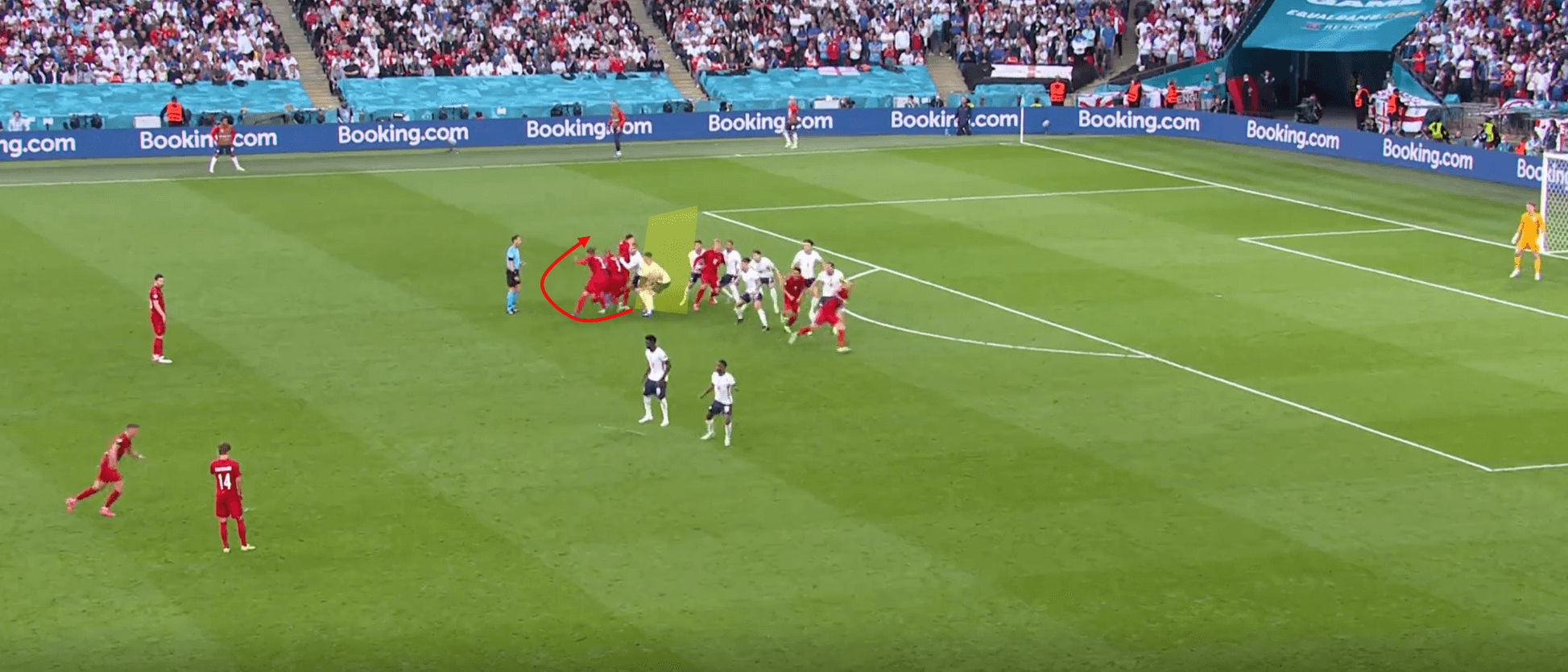
Routine two- Harry Maguire’s goal against Ukraine
Harry Maguire’s goal against Ukraine showed not only a common trend in England’s set pieces but a common trend in many teams’ free-kick movements. England start with two players over the ball, and target player Maguire starts in an offside position at the far post. The key to this whole routine is Raheem Sterling at the front post making an early movement forward, and this is combined with a little feint from Jadon Sancho over the free-kick. We see here Sterling starts his movement early.
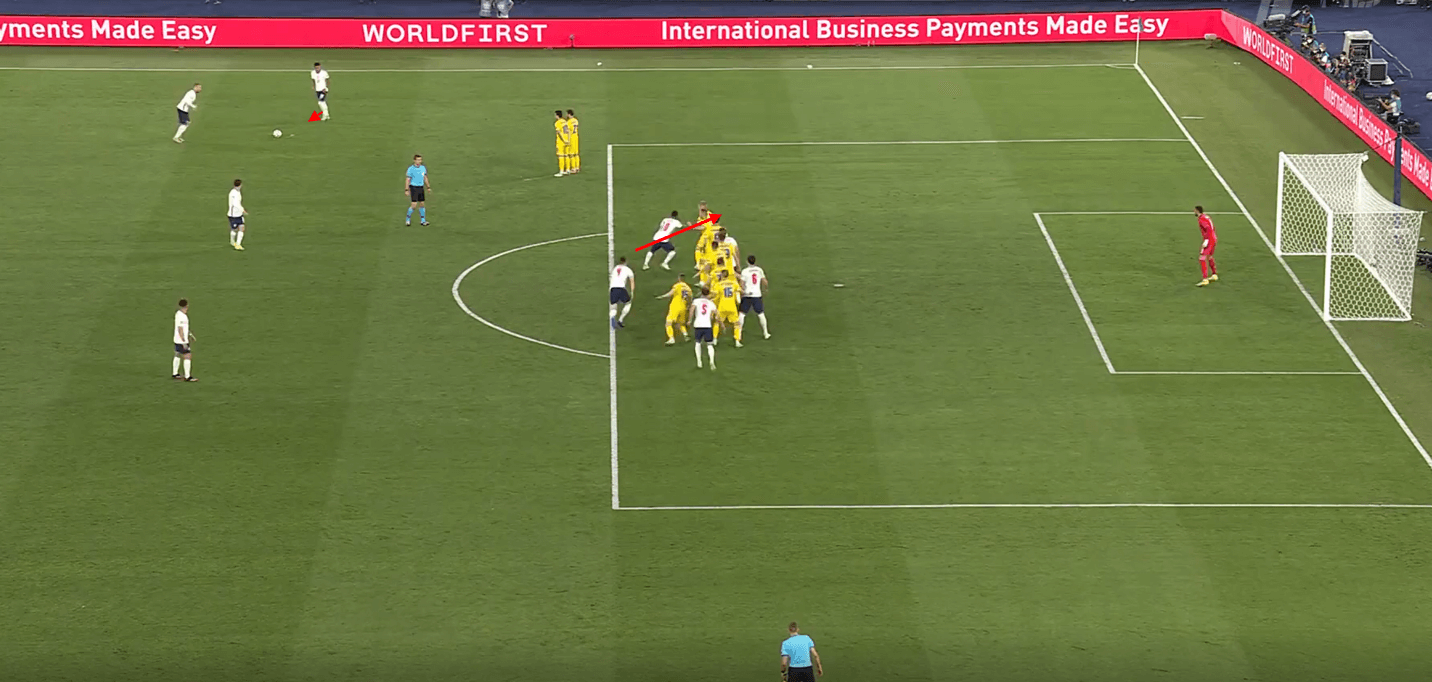
Sterling’s early movement, combined with Sancho’s feint, causes the Ukraine near post defender to drop off early in reaction to Sterling, and this near post defender now plays Maguire onside at the far post. Maguire’s offside positioning allows him to be goal side of the Ukraine defence, and the outswinging delivery by Manchester United full back Luke Shaw exploits this space behind the Ukraine line well for a goal.
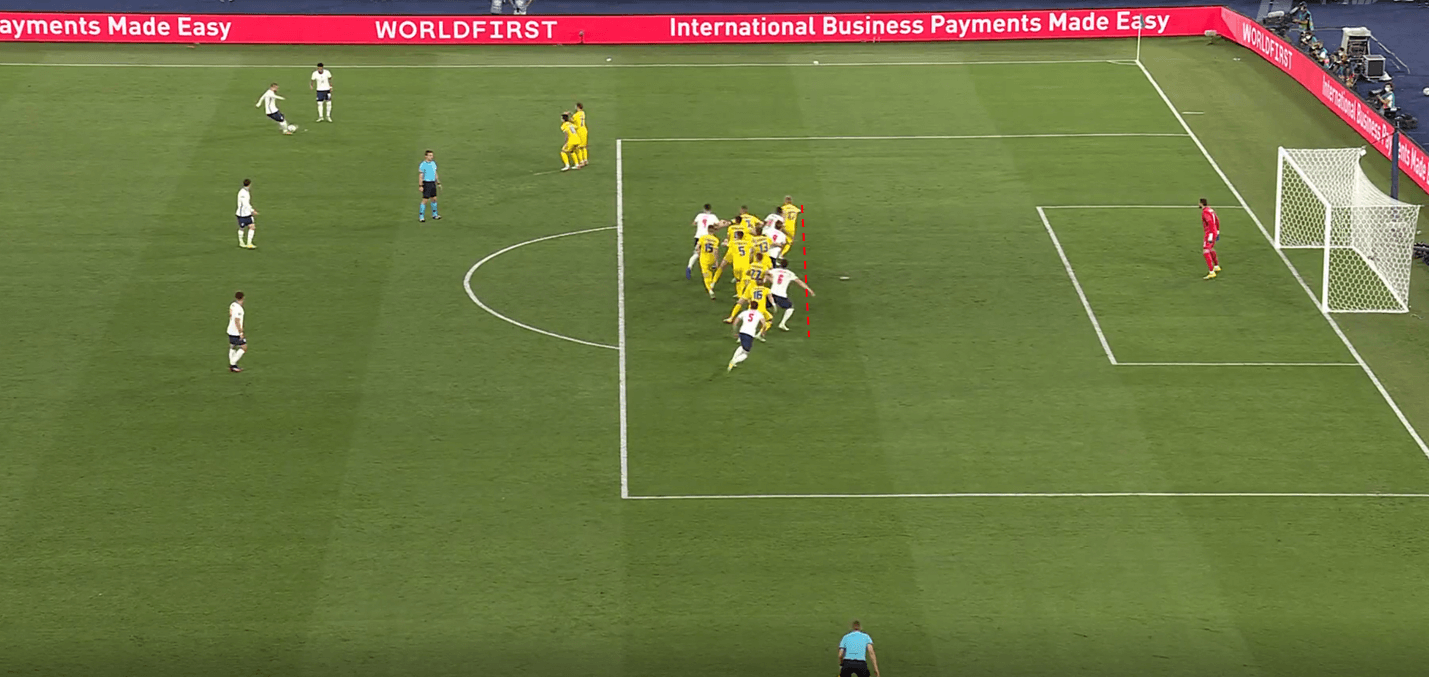
Routine three- Vacating the front post and using offside runners
This routine from Spain is effectively the opposite of the England routine, with the front post now the target thanks to back post runs. Spain space three players towards the back post, one player centrally, and leave only Koke in the near post zone in an offside position. This focus on committing players to the back post shifts Switzerland’s zonal line across to the far post, and so the near post space becomes more open. Koke is offside in this area so is not covered. Spain’s back post runners move early and from deep areas at speed, and so they force the Switzerland backline deeper.
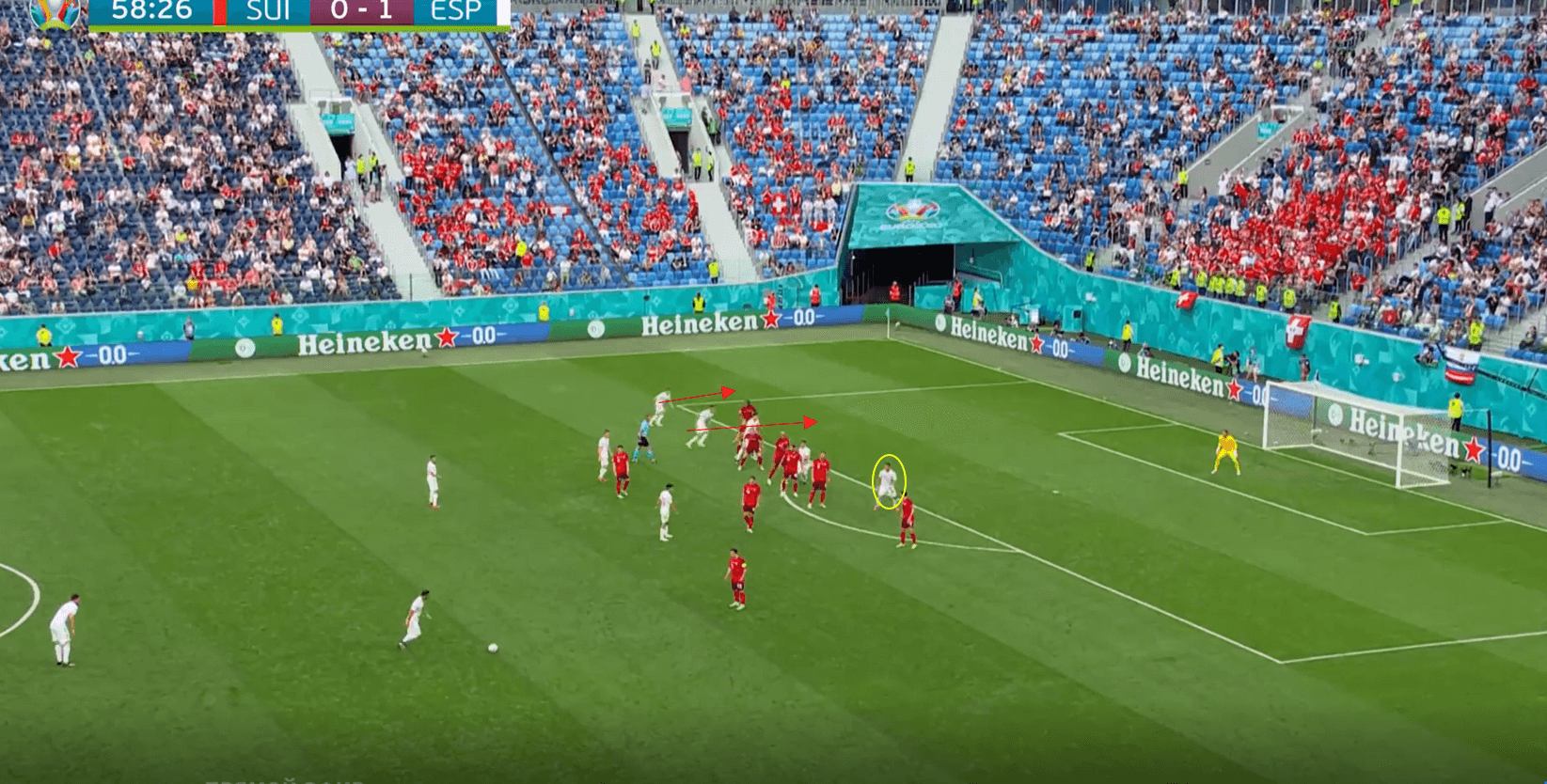
The movement of these earlier runners allows Koke to be played onside in this near post zone, and the spacing of Spain gives Atletico Madrid‘s Koke a nice little pocket to receive into. Koke receives the delivery on his chest and gets a contested shot off. The obvious disadvantage to this kind of routine is the technical difficulty of controlling and striking a ball coming across you.
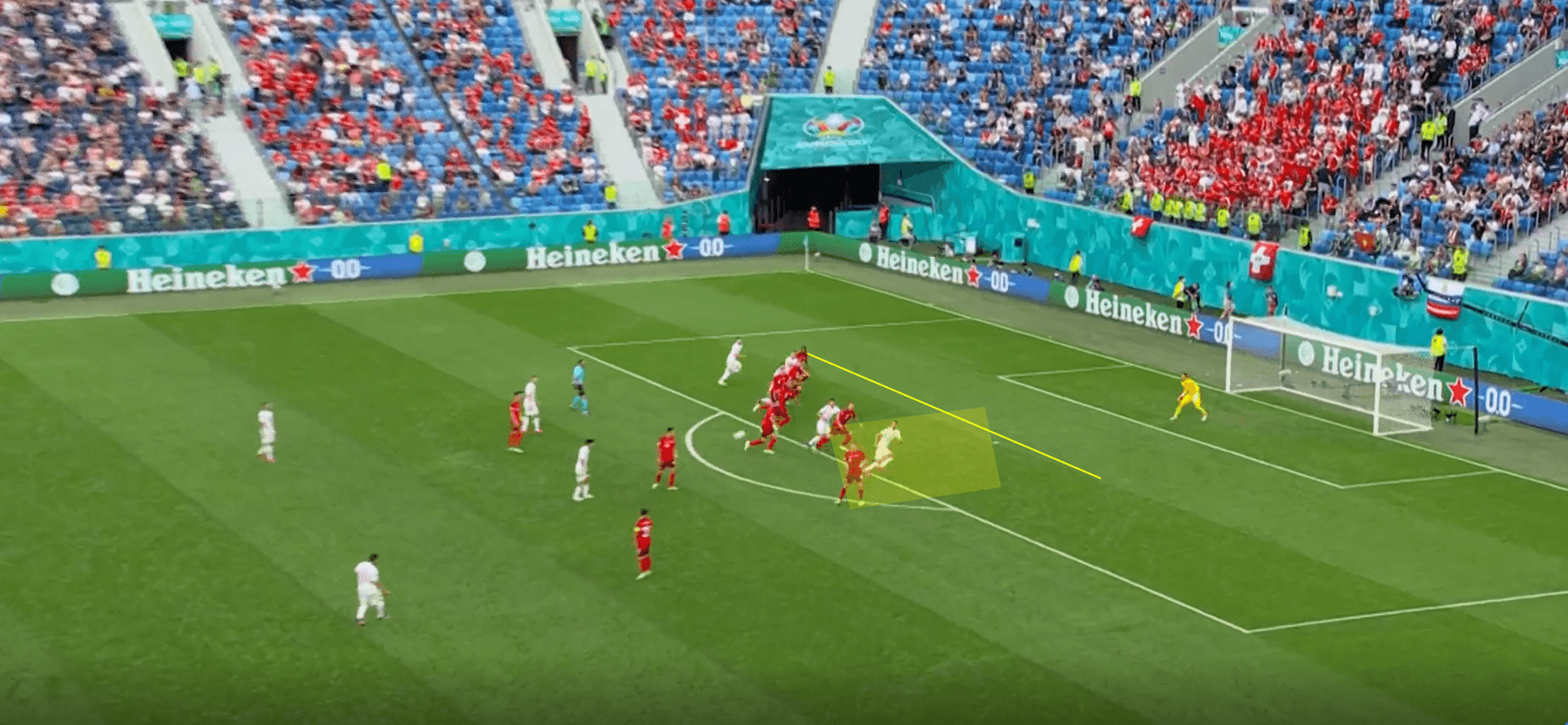
Routine four- Italy’s chipped free-kick to exploit high line
The first of four Italian routines in this tactical analysis shows a good solution to high lines from free kicks. Again, spacing is key, and Italy space three players wide towards the far post, including one of their usual target players Leonardo Bonucci. The near post and centre are pretty vacant, with only Chiellini present initially in an offside position. Immobile starts more towards the back post and makes a quick darting run to go in behind. Italy also have two players over the kick, and Emerson walks towards the ball just before Insigne takes the kick, which aims to affect Spain’s dropping movement.
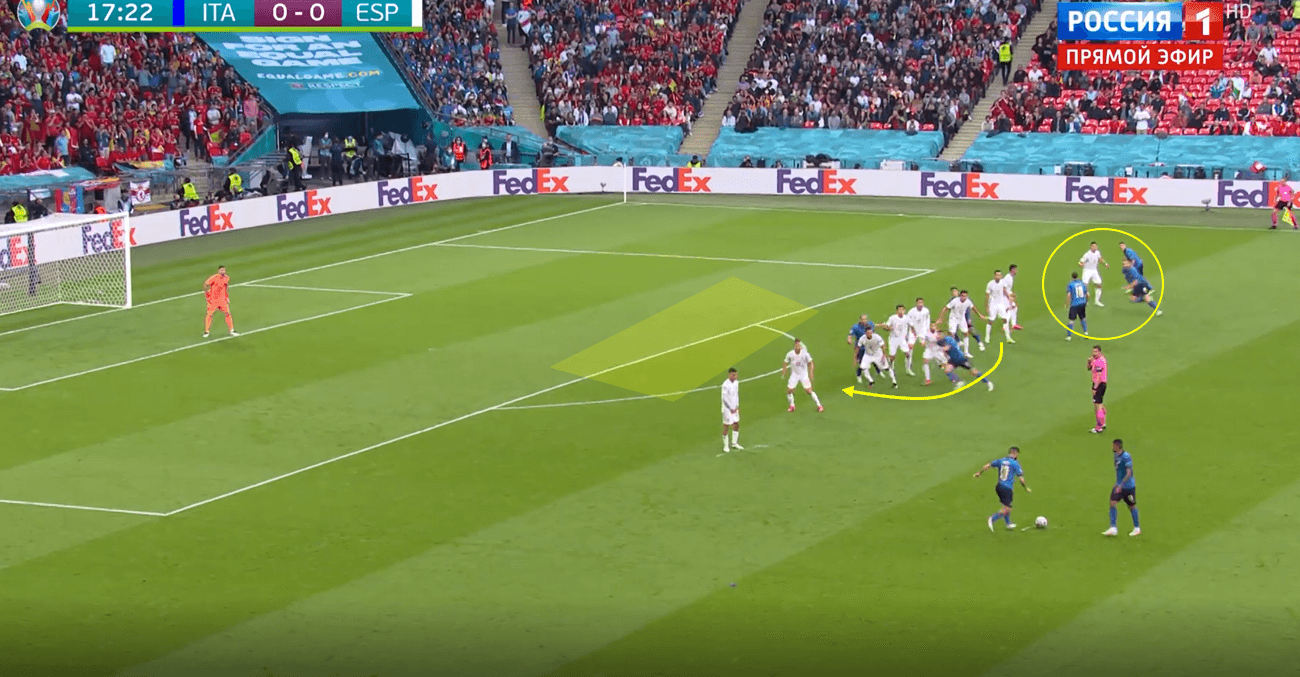
Chiellini’s offside positioning behind a central defender allows him to block the Spain defender from dropping once the ball is played, and so it opens a lane to chip the ball into. If no block is applied, the chipped delivery would likely be intercepted by a central player, and so the block creates space for the chip to reach a player. Players have to time runs well centrally, and Italy do that well here. The delivery is just slightly too far to the left, and Spain’s goalkeeper Unai Simon is prepared to step out and claim the ball. The routine was fairly predictable too, as watching the game in real-time I could see the chip was coming, and Insigne also showed it with a little head signal to Immobile.
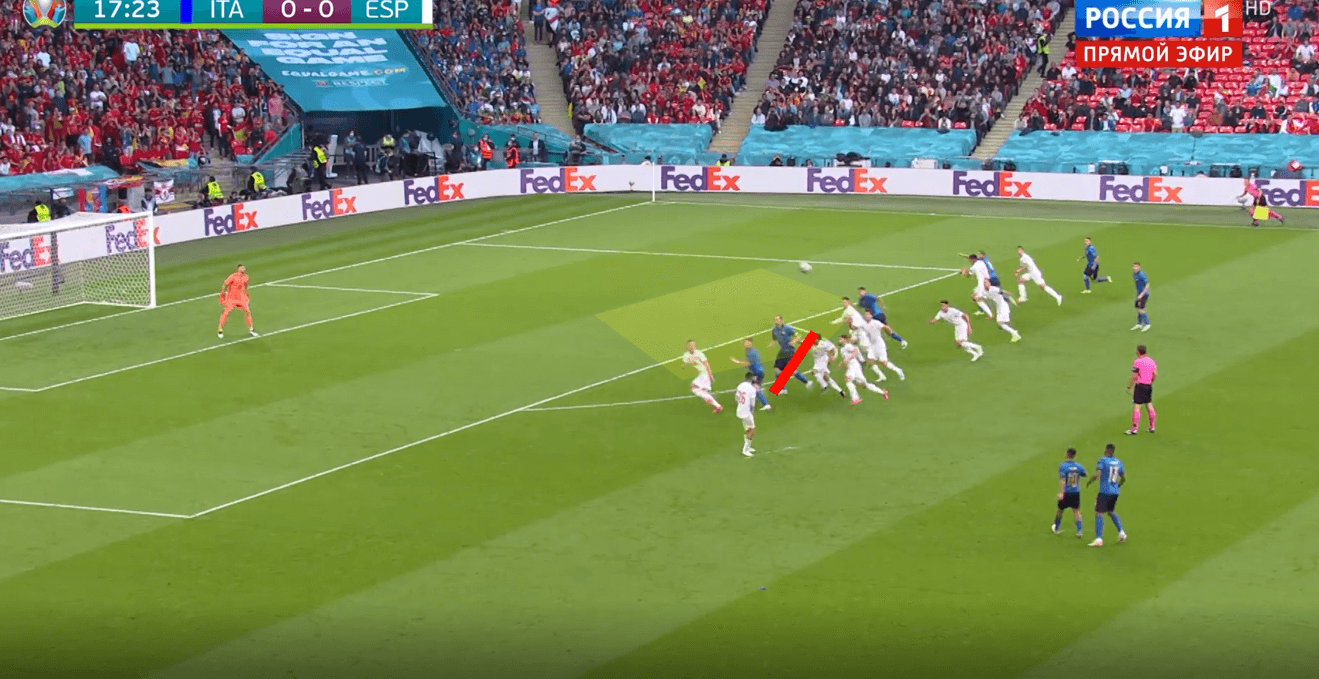
Routine five- More Italy offside tactics
Italy regularly used offside players to their advantage on free kicks, and their goal against Wales was a good example of this. We see their initial structure here, with two offside players in a central position (one of which is Bonucci again), a player stretched wide at the far post, and two deeper central players. They also have two additional players deeper to deal with the second phase. Two players stand over the kick.
Their spacing, therefore, focuses centrally initially, and so Wales zonal line stays more central. This opens some space at the far post and opens space at the front post too which Italy target.
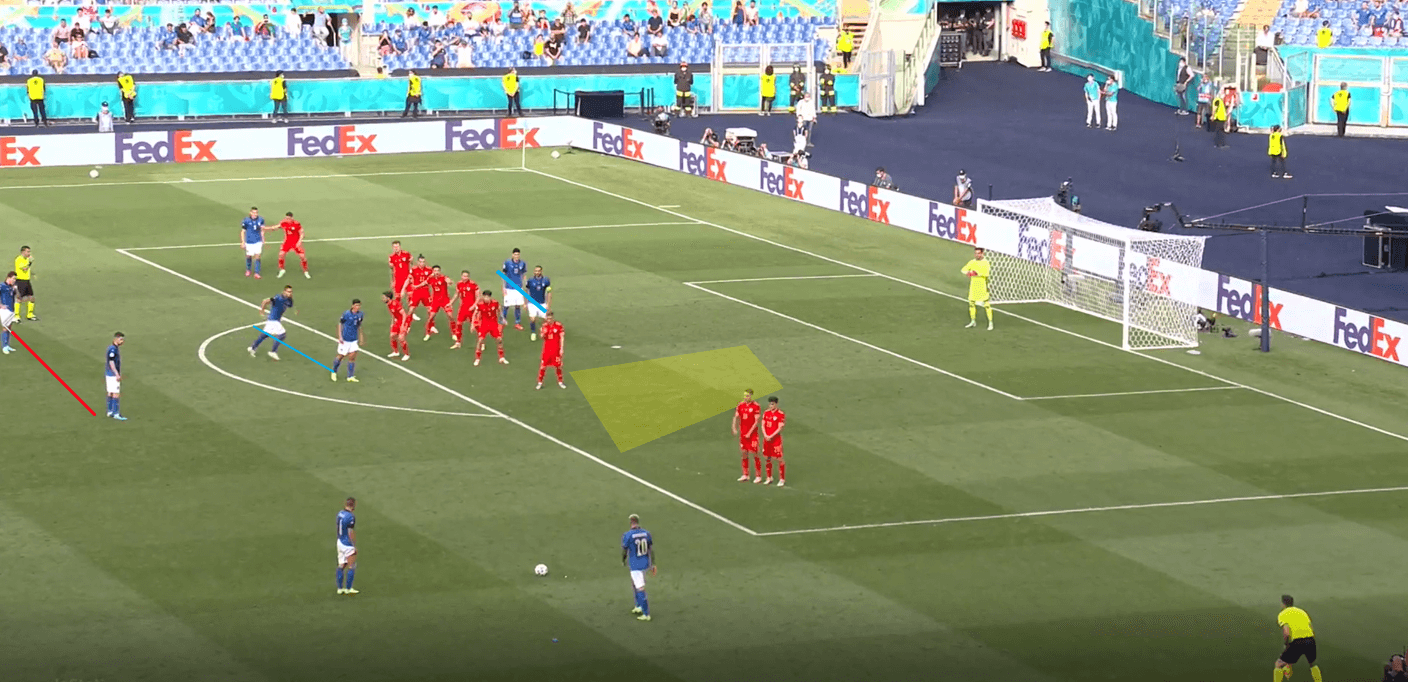
Italy’s inswinging taker moves to the ball and feints a delivery here, and so in reaction, a Wales defender (Bale) drops back quickly to try and cover those two central offside players, and we see he plays everyone onside here.
The two deeper central runners both move towards the near post, and they time their runs brilliantly to arrive at different times, with the target player arriving latest.
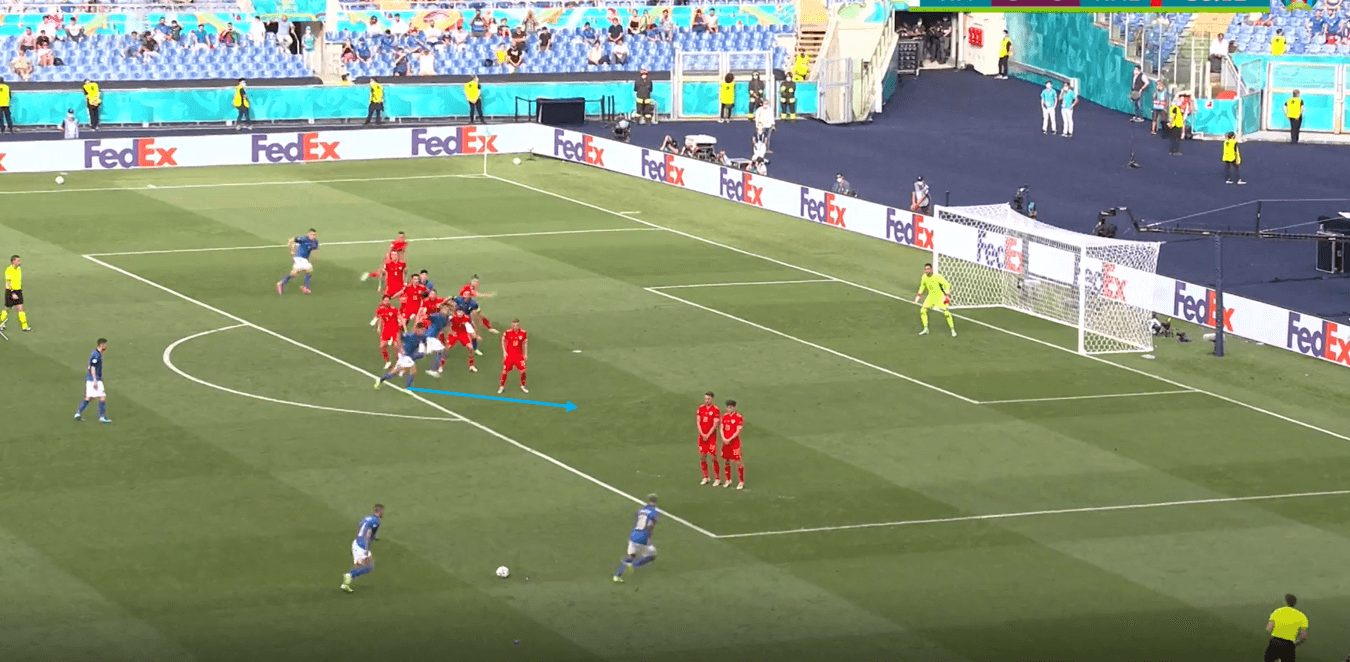
Pessina’s run is timed well, and he nips ahead at the near post and finishes well into the far corner. The initial offside players didn’t actually need to try and play anyone onside, but their central positioning helps to open this space. We’ll see lots more of Gianni Vio’s set-piece routines for Italy in the next section which focuses on corners.
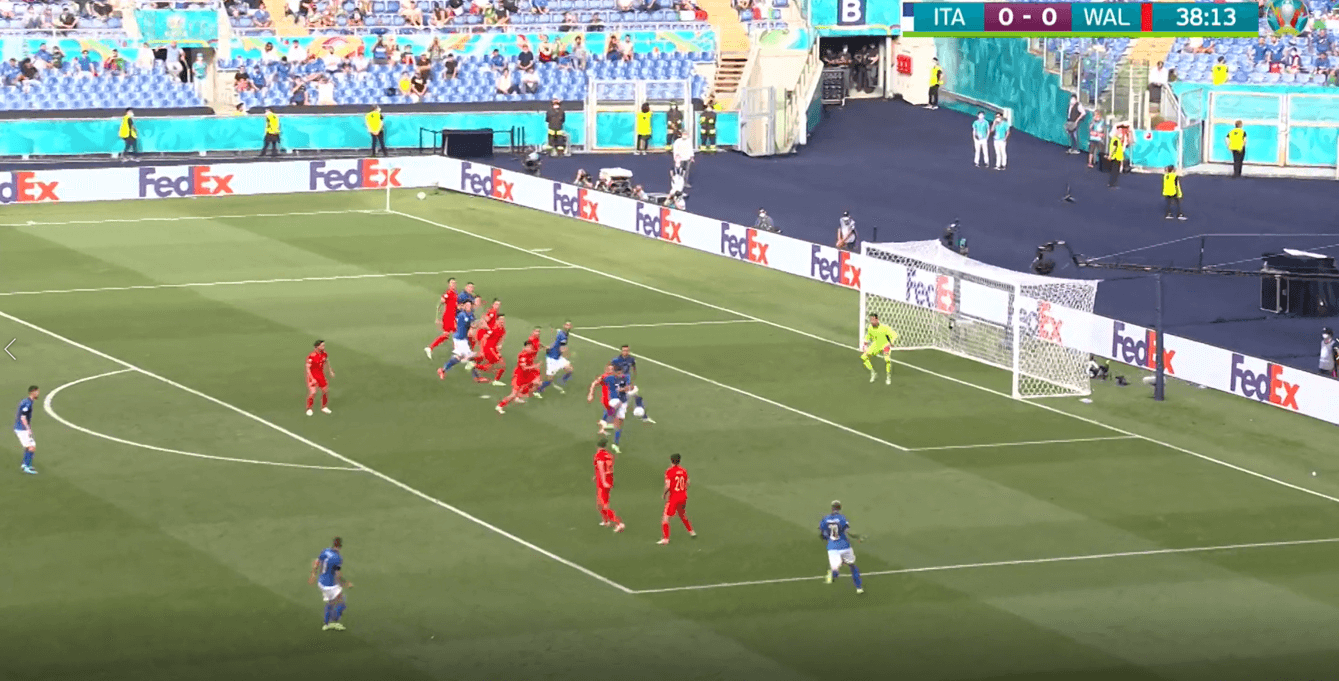
Routine six- Croatia cutback
Croatia were not a particularly interesting set-piece team at the Euros, but they did use a nice routine against the Czech Republic which created a good chance. Croatia starts with four players spaced more towards the back post in a group, and they play short. The short player and corner taker (Modric) play a 1-2, and so Modric can play towards the box on his strong foot. Within that back post group, the furthest player (Perisic) makes a movement around this group of back post players and moves towards a deeper central area.
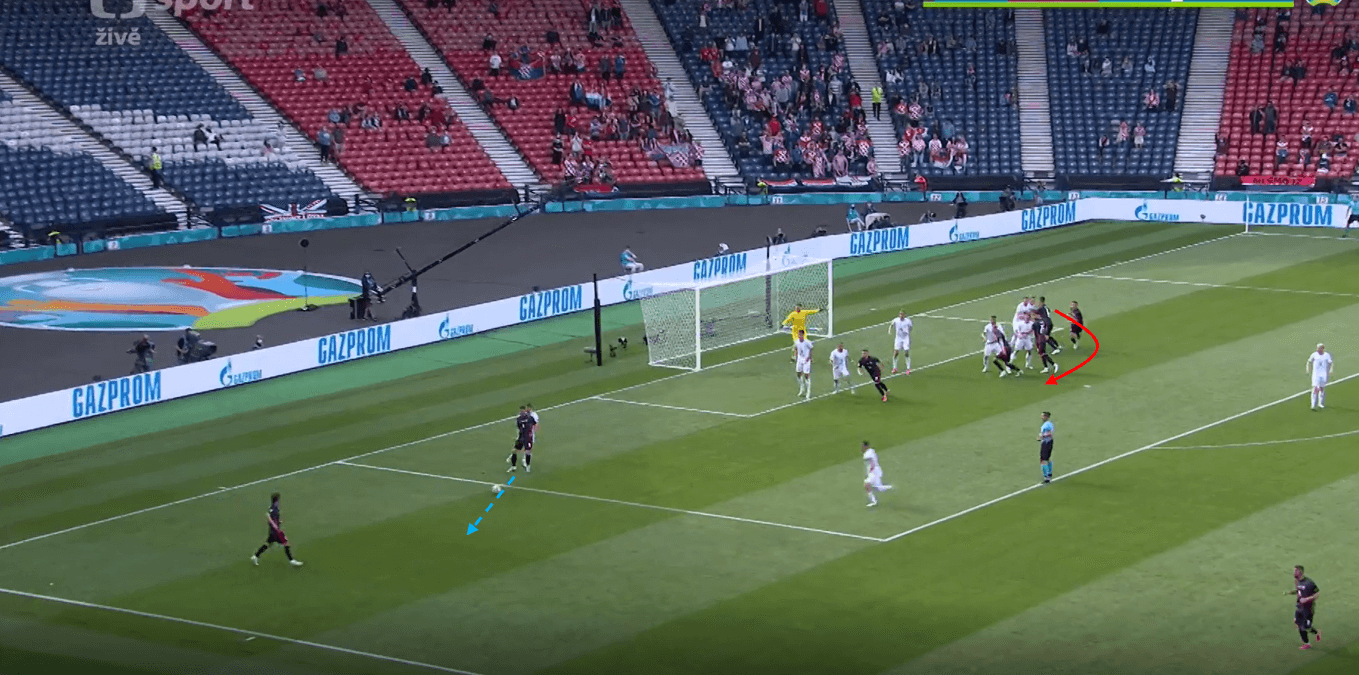
Modric receives the one-two, and Perisic is able to move around the traffic at the back post while his marker (circled) gets stuck in this traffic and so cannot follow him. As a result, Modric can square the ball to Perisic, and Croatia do a good job of vacating the space in front of goal to create a lane to shoot through. The shot however is tame and along the floor, and the Czech keeper makes a routine save.
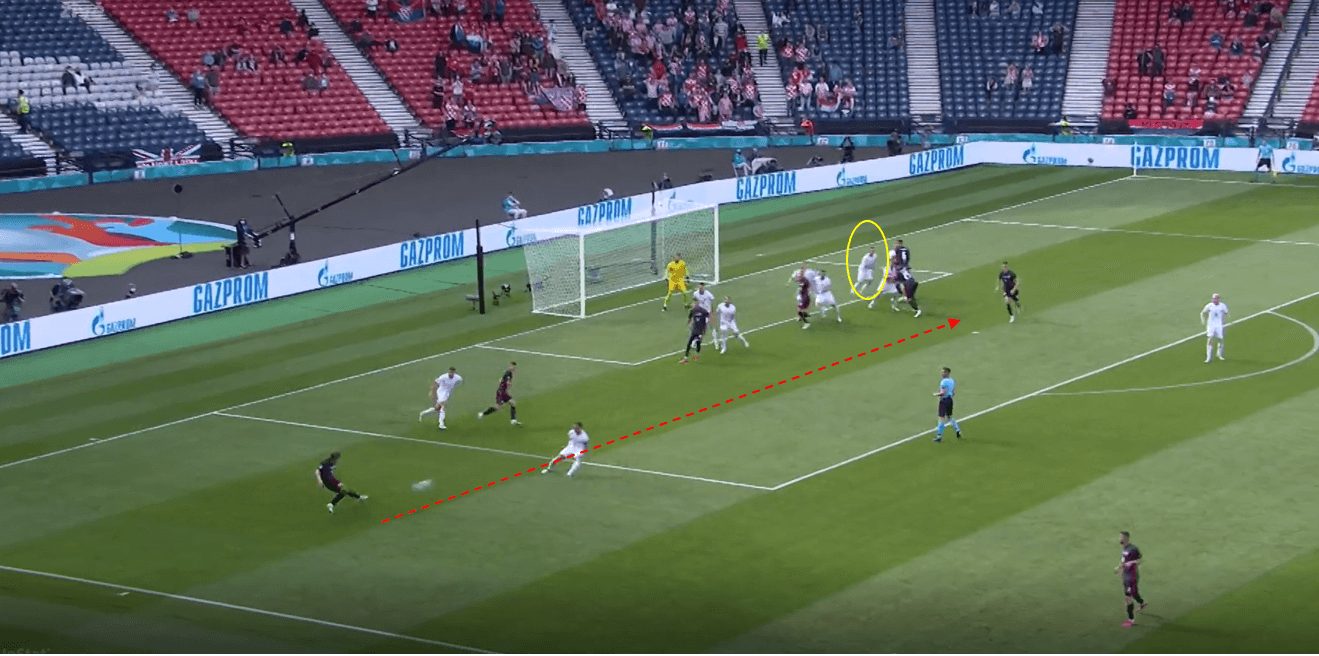
Routine seven- Switzerland’s simple dismarking
This routine is the most basic in this piece, but well-executed simplicity is sometimes all it takes, especially against your more man-oriented systems. Switzerland start in two pairs and position centrally. The pair on the penalty spot act as the targets, and their spacing leaves the near post vacant. The player furthest from the corner taker in the pair makes a movement around his teammate, and in doing so creates separation from his marker, as both the attacker and defender have to move around the players near them.
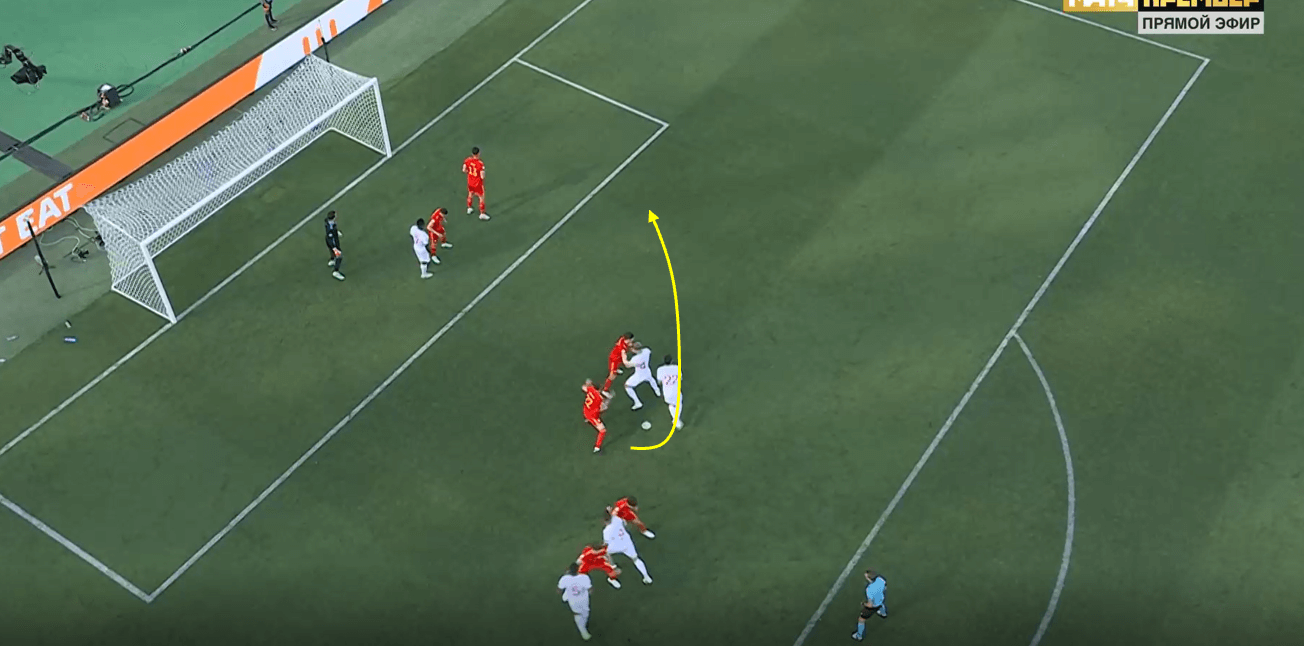
This movement around his teammate allows the target player to get away from his man, and because there is no contact between the attacker and defender, it effectively becomes a foot race, and with the defender having to react to the attacker’s movement, it is hard for the defender to win this race. The Swiss attacker moves towards the corner of the six-yard box and flicks the ball towards goal, where the ball is well saved by the goalkeeper. Wales’ system is very reliant on man-marking here as their zonal coverage is really poor, so if you dismark and space well you get a free shot.
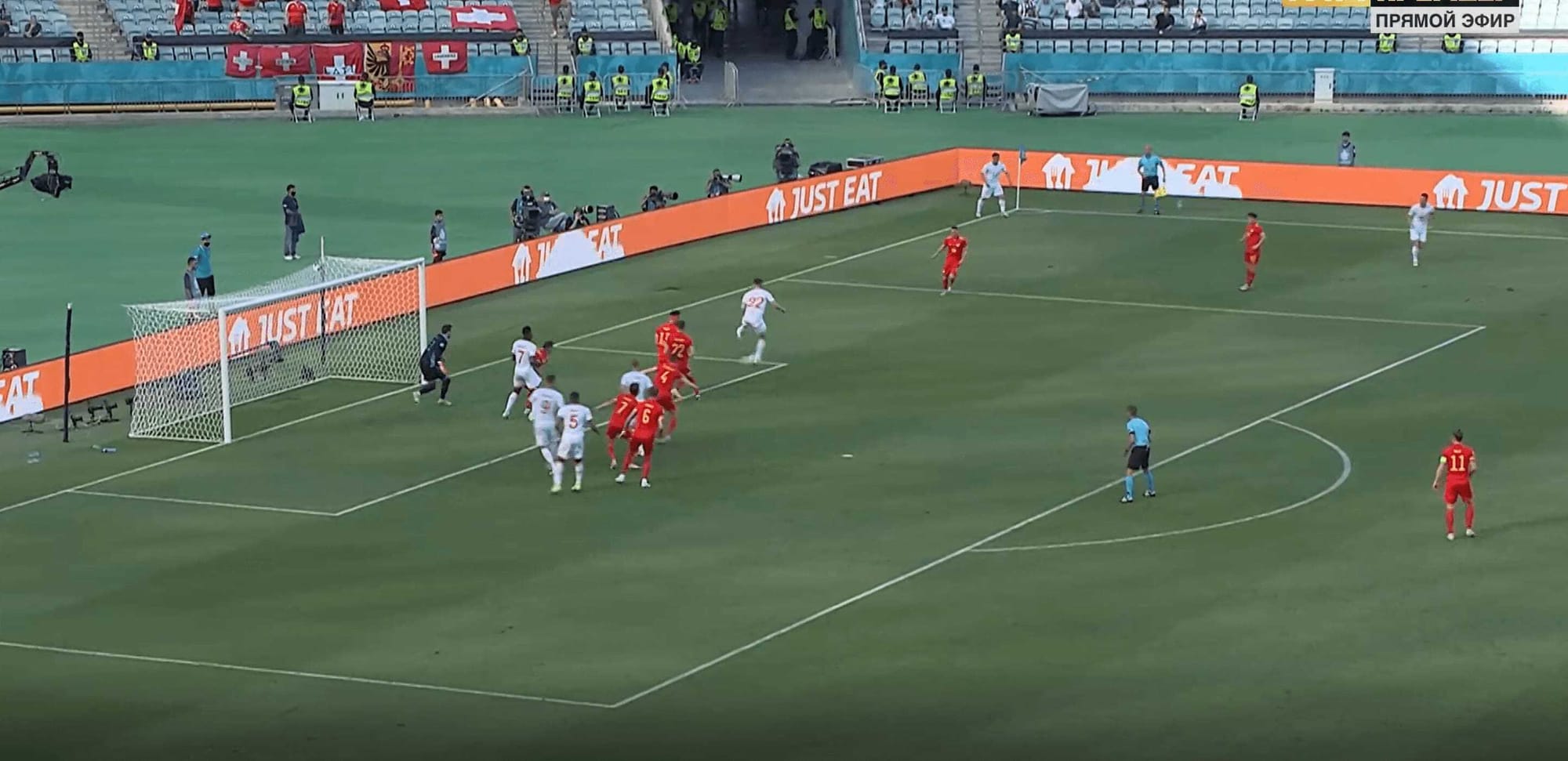
Routine eight- Staggered runs to exploit zonal systems
A key skill for any team attacking a more zonal system is the use of staggered runs in deeper areas, and Spain utilise this well here against Slovakia. Slovakia set up in a four-player zonal system with three blockers in front of this. Spain pull a player short to help reduce Slovakia’s numbers in the box and commit three players within the zonal shape, two deep runners in the box, and a runner from deep outside the box. The players closest to the goalkeeper make near post runs, presumably to try and attract Slovakia’s structure further across and away from the centre.
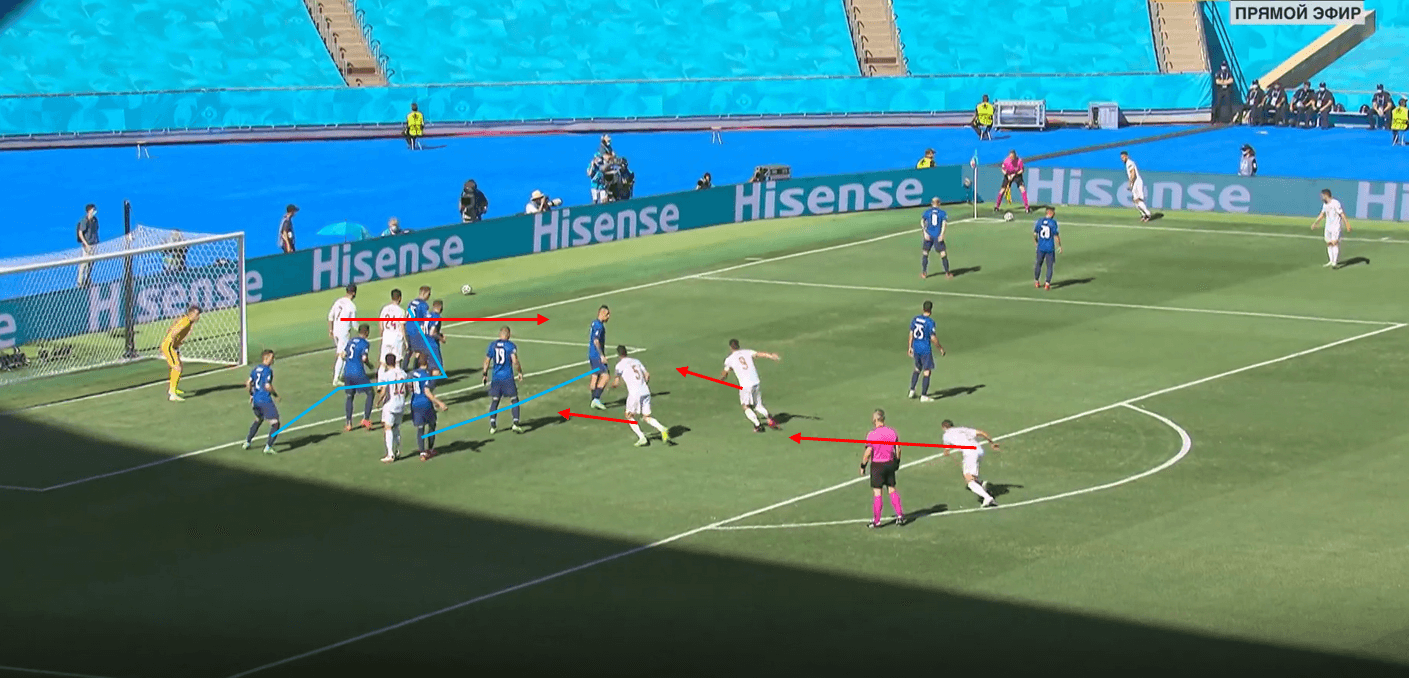
The two deeper runners within the box don’t aim to win the ball, and instead act as blockers on Slovakia’s blockers in front of the zonal system. We see both players move towards the nearest Slovakia players and try and restrict their movement, and this creates a large central space for Azpilicueta to arrive into. The use of an outswinging delivery allows them to access this deeper zone, and so Azpilicueta should have a free header from the penalty spot. Number five though (Skriniar), pushes out brilliantly here to get to Azpilicueta and win the aerial duel. Skriniar has no right to get to the ball here really, but Spain’s player closest to the back post could potentially have blocked Skriniar, as he is very good in the air as any Serie A fans will know.
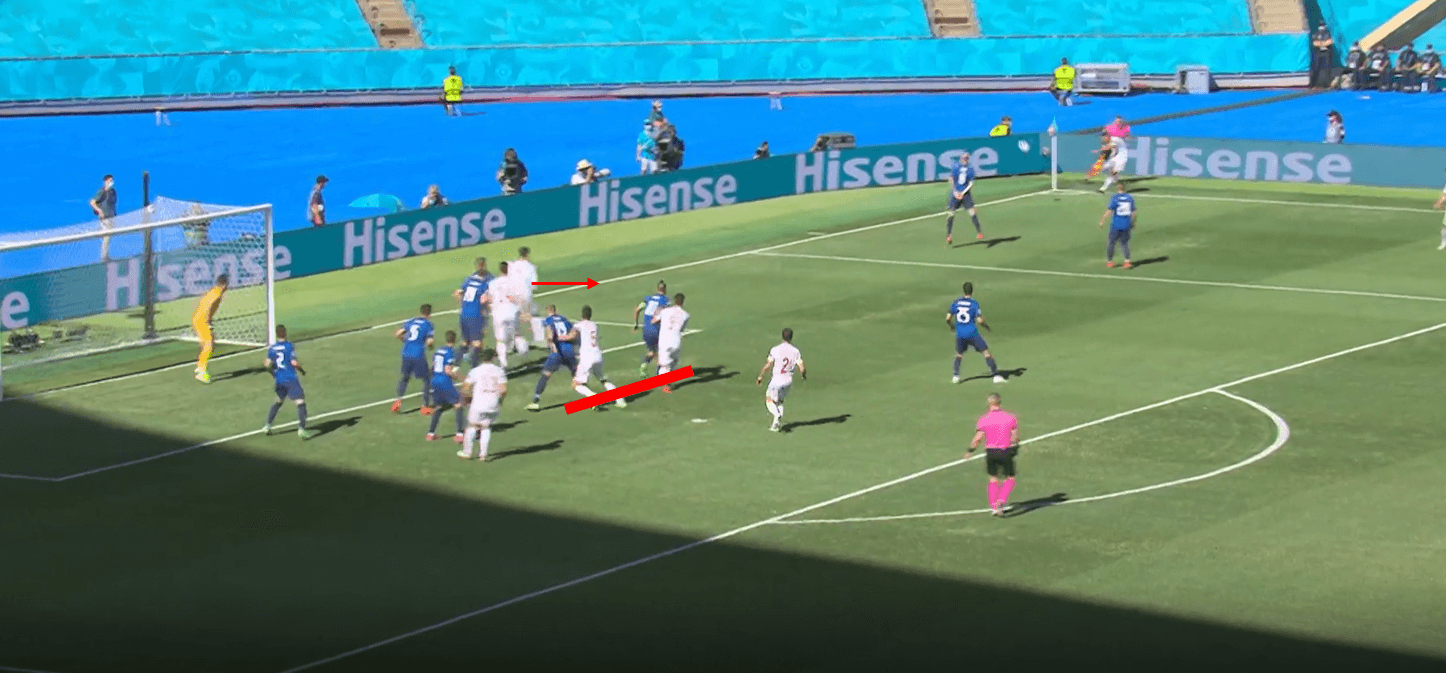
Routine nine- Gianni Vio’s decoy runs
Italian set-piece specialist Gianni Vio seemed very keen on decoy runs at this tournament, and Italy used these often to try and win first contacts. They used these regularly against England as I explained in a recent tweet, but one of their best examples came against Austria.
Here Italy vacate any higher area of the box and commit seven players deep to the edge of the box, which is an unusually high number of players to have in the box. They commit a player short to drag a defender out, and so we see on the edge of the box Italy are 7v5. The nearest player to the front post, Chelsea midfielder Jorginho, makes a movement forward initially and occupies a player, and Jorginho then moves back away from the box. Because Jorginho engages a defender though, his movement wider opens a lane for a runner towards the near post. Two Italy players move towards this lane, and due to their deep positioning, they have some separation from the Austrian defenders already.
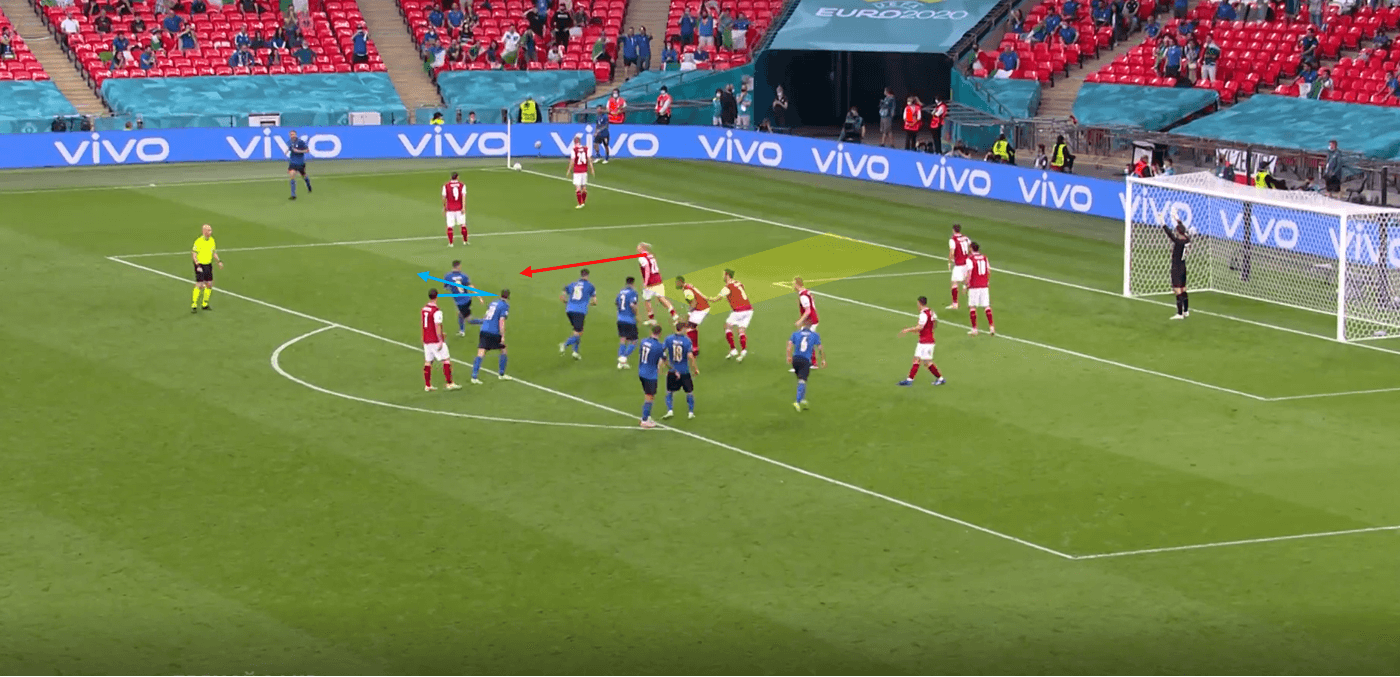
We can see here that Jorginho’s marker has been dragged higher, and Italy have two players targeting this near post zone with separation created. Due to having so many numbers forward, we see Immobile here is left as a free runner at the back post, and he aims to get on the end of a flick from that near post zone. Italy create enough separation to win the ball in this near post area on the inswinger, but the flicked header is slightly too powerful for Immobile to get on to. Two of Italy’s initial deeper runners have moved onto the edge of the box as we can see here, and this gives them stability and the potential for a shot in the second phase. If slightly more separation could have been created at this near post zone, perhaps more success could have been had, but nevertheless, it is still an interesting routine.
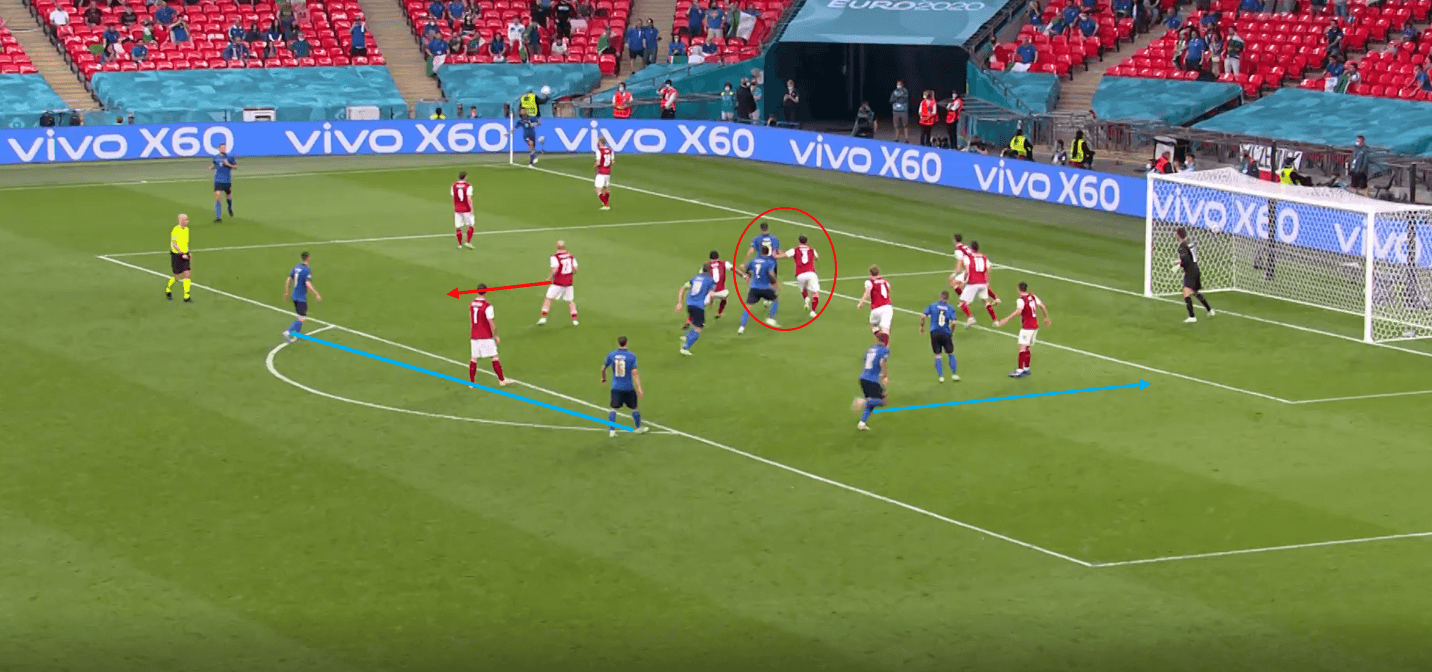
Routine ten- Two corner takers causing problems
A few teams, most notably Ukraine and Italy, used two corner takers at times to create space. Having two players over the corner is useful as it means the defensive team doesn’t know if an inswinger or outswinger is coming, and so they can’t set how high they want to stand based on this. We can see here Turkey use one zonal player, and defenders tend to protect the deeper area more in these situations, as it is riskier to leave space closer to goal. Yilmaz is deep here, and Italy structure mainly towards the back post and centre, with players facing towards the near post. Nicolo Barella stands very loosely marked on the edge of the box.
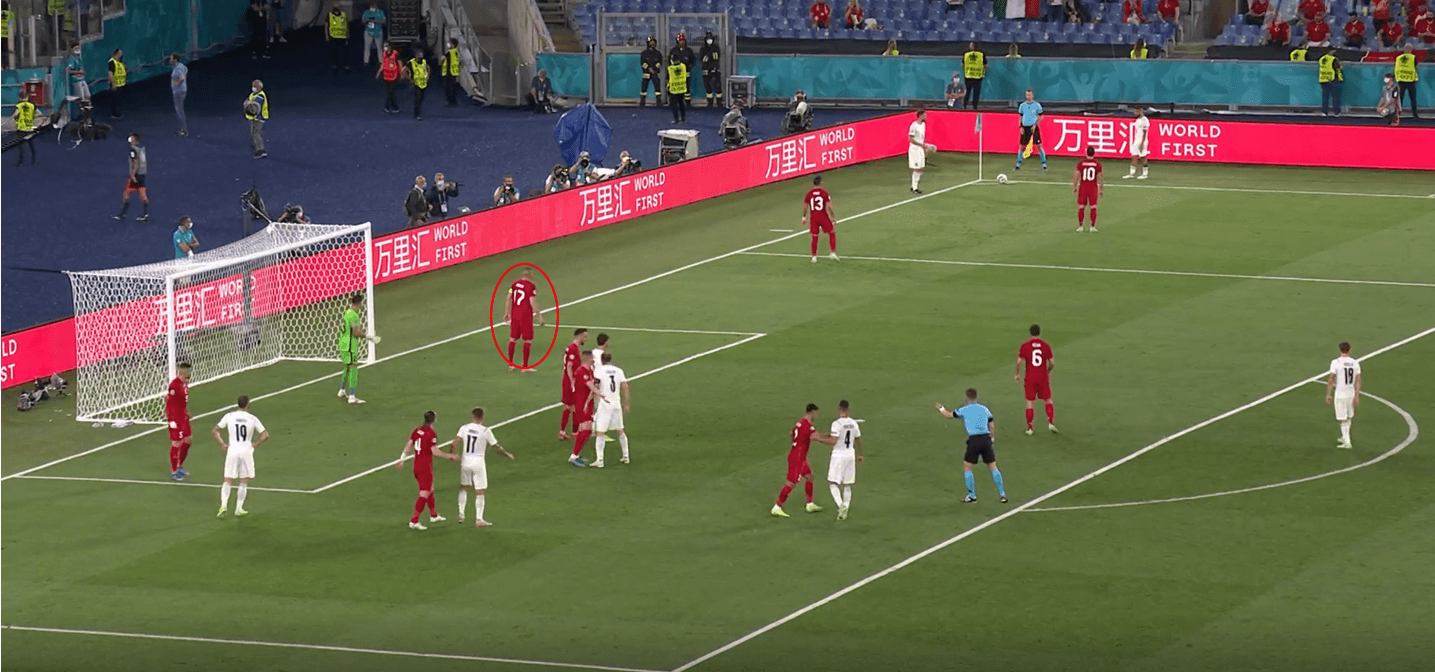
The inswinging deliverer on the corner moves away from the ball once everyone is set, and so the outswinger option allows them to access deeper spaces, which because Yilmaz stays deeper initially, he is unable to cover. Two central players move towards the near post space, while the rest of the players stay away from this zone. Number five Locatelli moves towards the edge of the six-yard box, and this would be a useful decoy run if not for Bonucci’s run into the same space. Nicolo Barella times his movement to get into the box and aims to arrive into that near post zone.
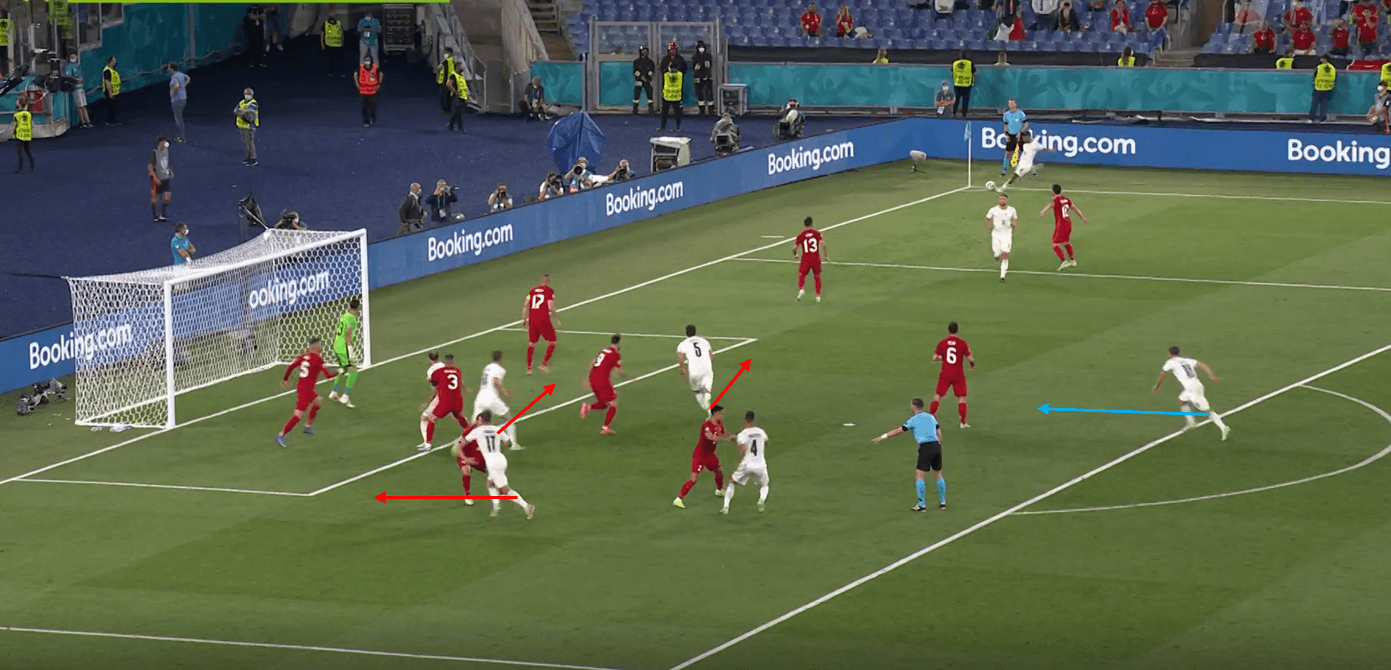
Barella arrives into this space really well, but it is ruined by the movement of Bonucci into this same zone. Italy still win the first contact (Chiellini caught offside), but a lack of coordination in the routine between Bonucci and Barella ruins the chance. If all of Italy’s runners stay away and vacate this near post space or move closer to the taker to increase the size of this space, Barella has a free header, and judging by Barella’s reaction, this seemed to be the plan. As soon as Bonucci heads the ball Barella gestures to him that it was his ball, and so despite its lack of success, I found this one of the most interesting routines at the tournament.
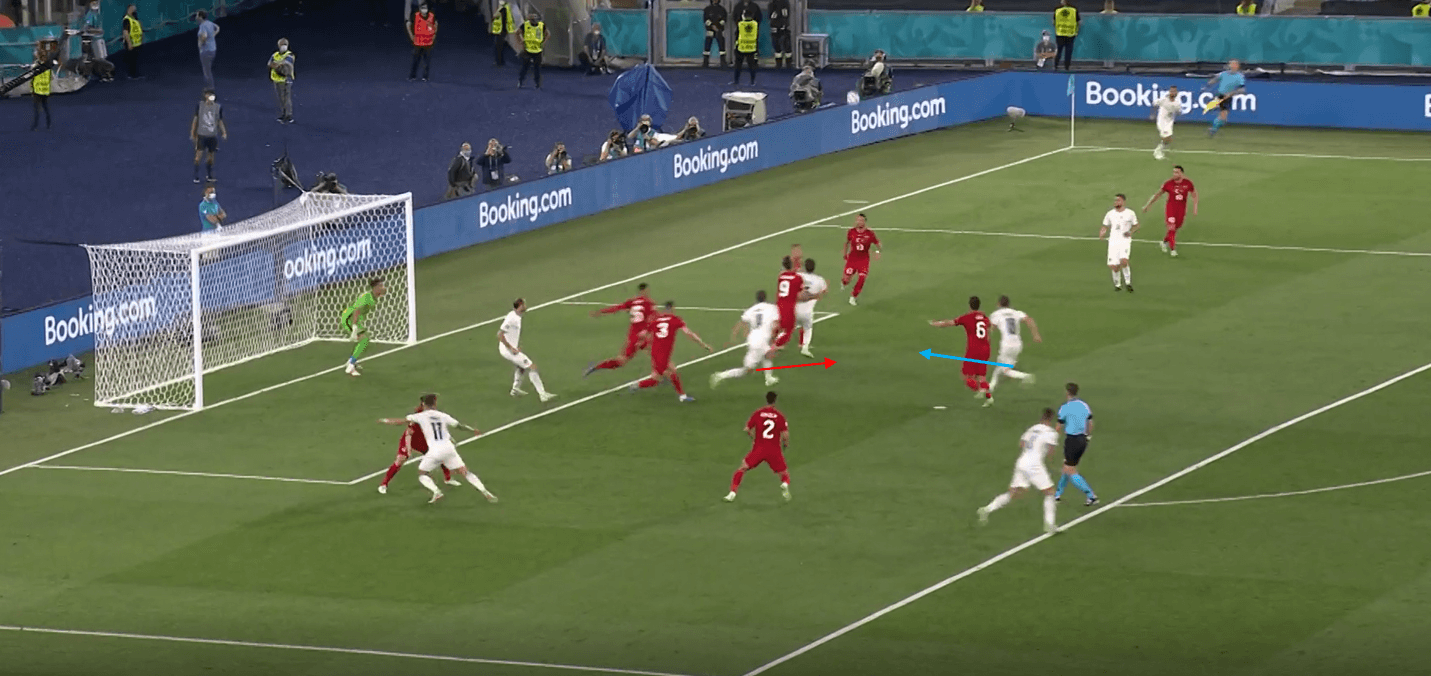
Conclusion
There were multiple other examples which could have made this list, with some honourable mentions coming from Denmark, Spain, and even a Ukraine goal. Other set pieces such as throws and direct free kicks haven’t been included, but high-profile routines like Denmark’s wall movement against England have been well documented already, and so I chose some of the routines which you likely haven’t seen from this Euros.
As you can probably gather from the number of examples in this list, Italy were probably the best set-piece team at the Euros, closely followed by England and Denmark. Gianni Vio’s expertise has already helped many club sides, and Mancini’s decision to employ Vio for this tournament proved vital, with Italy’s goal in the Final coming from a set-piece containing some of those decoy runs discussed.
England produced the most shots from set-pieces, but lots of these were low-quality shots often centred around Maguire, and so England weren’t as potent from dead balls as they were at the World Cup.
Despite there not being a massive quantity of goals, there was plenty to pick up from set pieces at this tournament, and hopefully, this set-piece analysis has given an insight into some of the set pieces used by teams at the tournament.





Comments